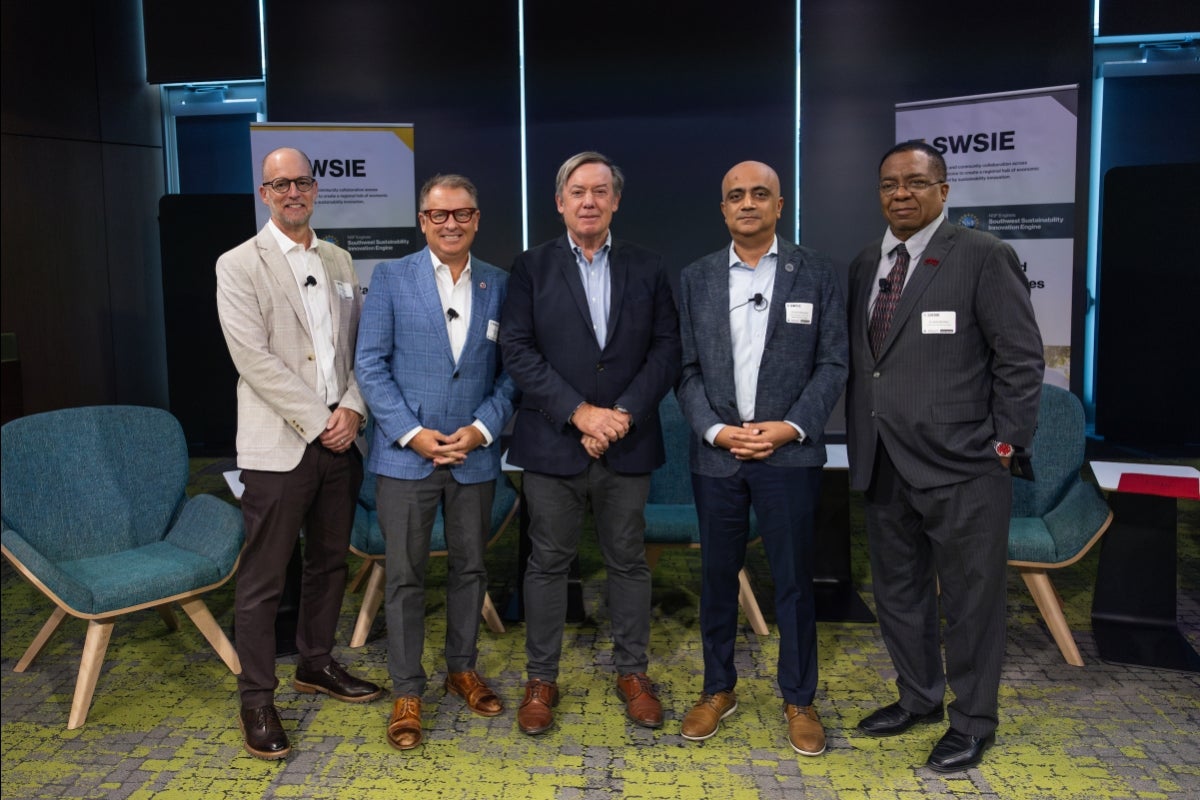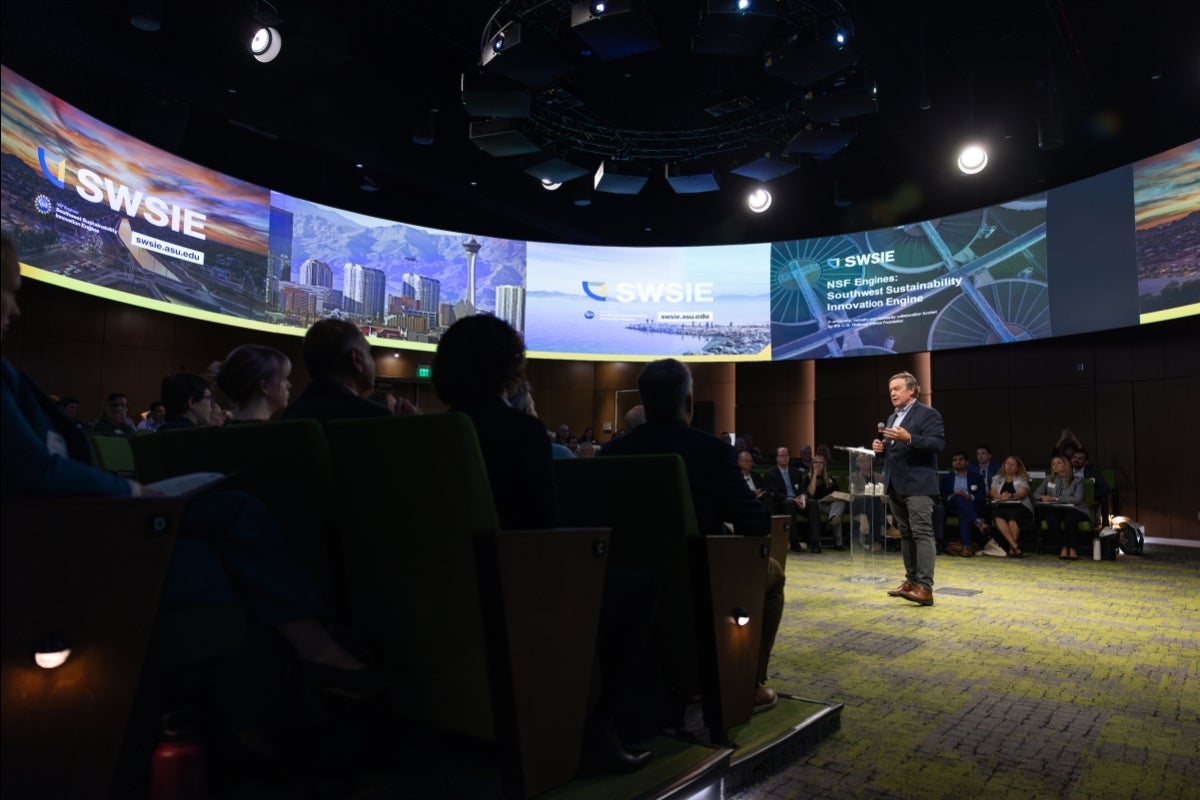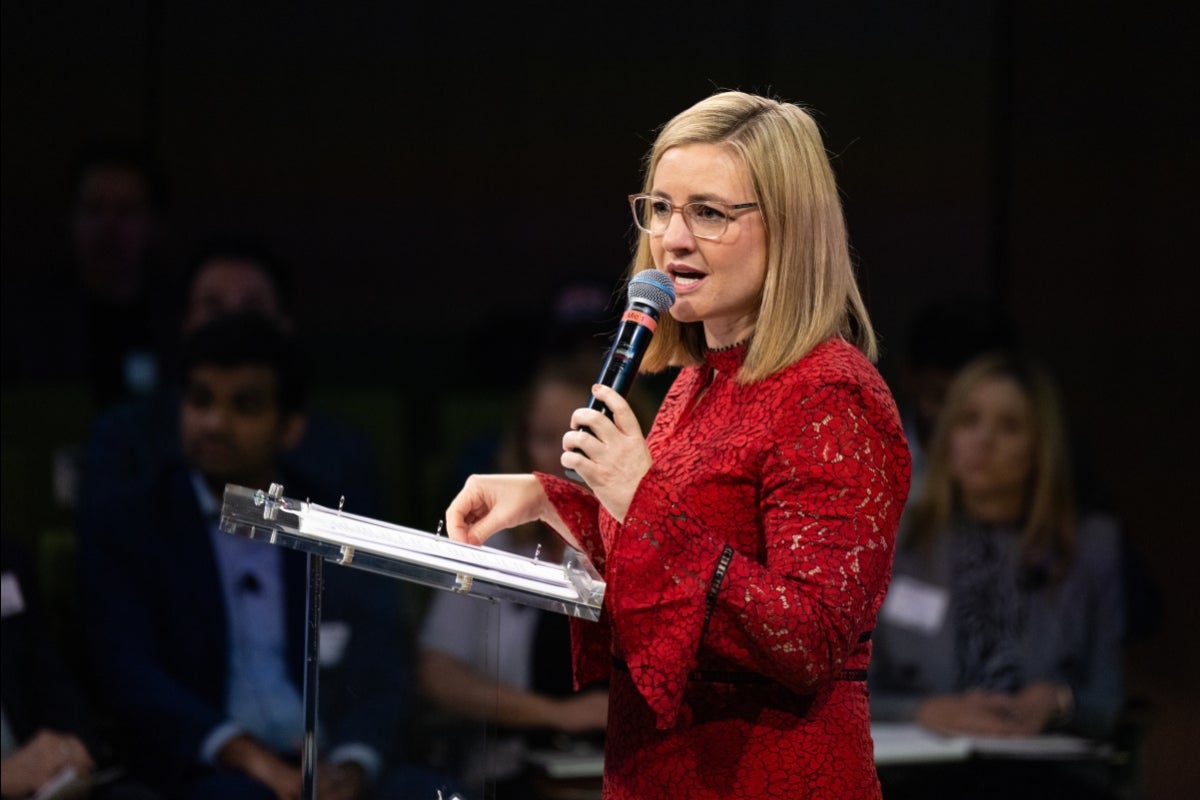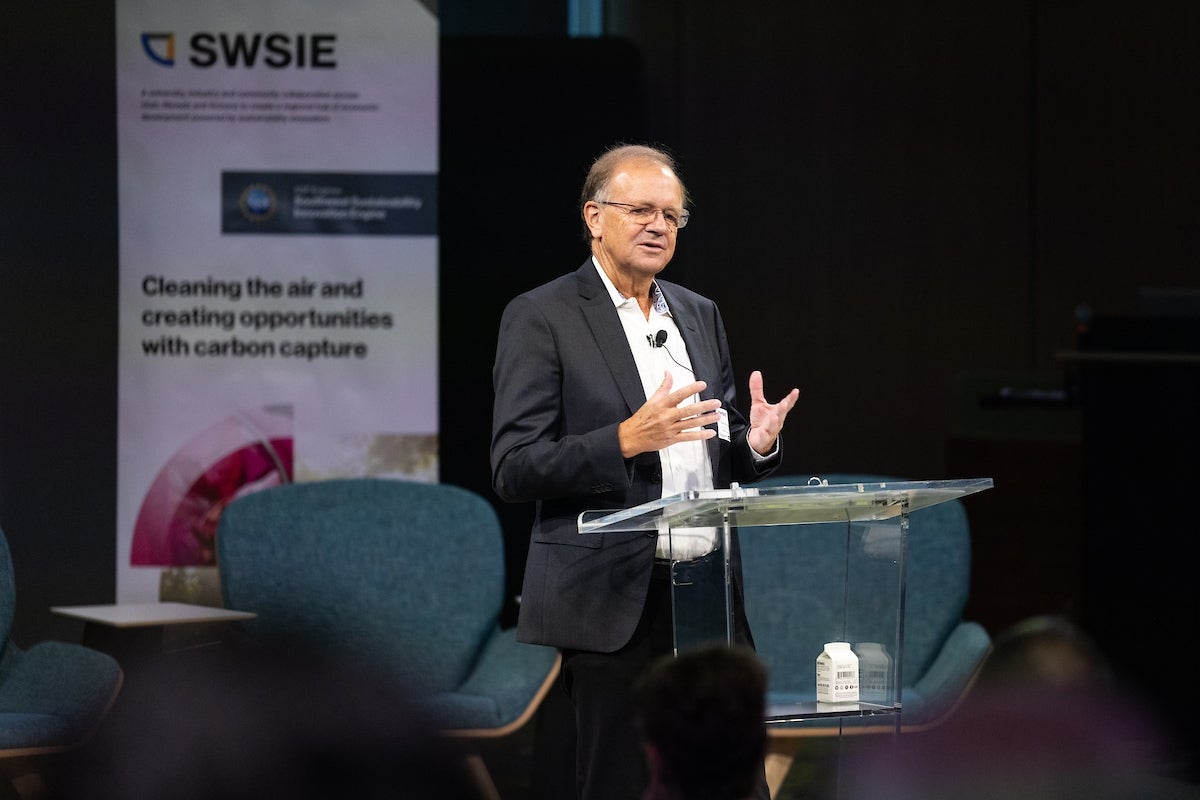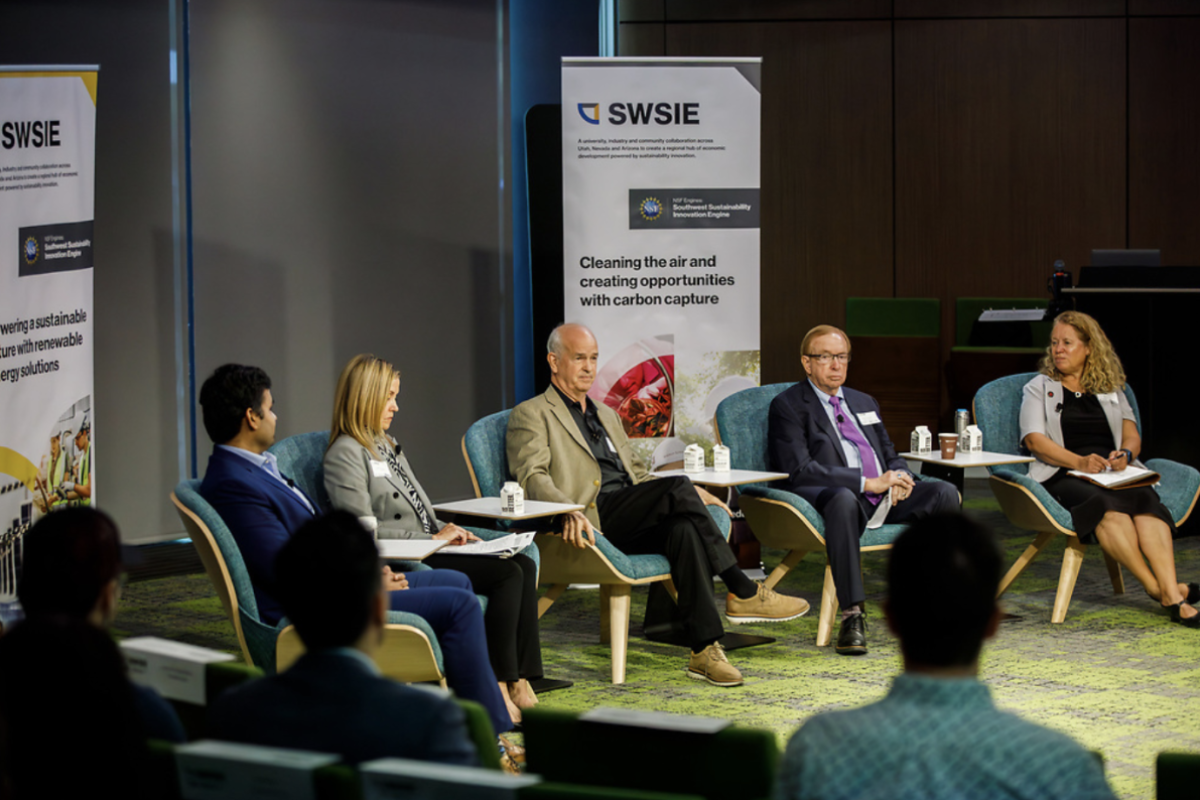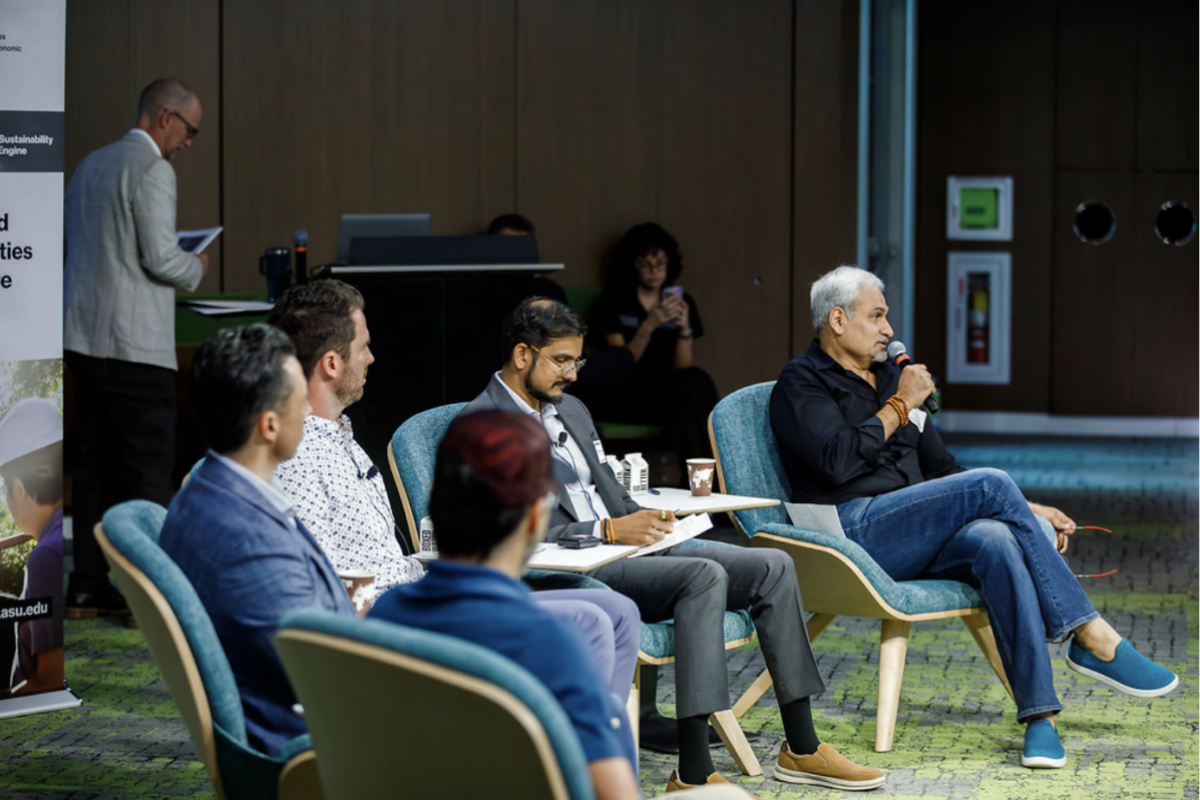A united front for sustainability and the economy

Brian Sherman, chief executive officer of the Southwest Sustainability Innovation Engine (SWSIE), speaks during the NSF Engines: Southwest Sustainability Innovation Engine event at ASU’s Walton Center for Planetary Health in Tempe on Oct. 15. Photo by Samantha Chow/Arizona State University
When four leaders of esteemed learning institutions and the mayor of Phoenix gather in one location at the same time, it’s a tip-off that something big is going down.
When they’re joined by visionary leaders in industry, government, nonprofit and philanthropic organizations, it’s a sure thing.
In this case, the fanfare was due to the Oct. 15 National Science Foundation’s Southwest Sustainability Innovation Engine (SWSIE) unity event. SWSIE is a regional hub driving innovation and workforce development in clean energy, water security and carbon capture sectors as part of the nation’s commitment to fighting greenhouse gas emissions.
“We live in volatile times. Signs of climate change are all around us, from the hurricanes currently battering the Southeast to droughts, wildfires and increasing temperatures in our own region,” SWSIE CEO Brian Sherman said at the event on Arizona State University’s Tempe campus. “Our mission is not only to prepare the Southwest and its citizens to survive, but to thrive and create a dynamic economic and social ecosystem … all in pursuit of a sustainable, prosperous future.”
SWSIE was formed in January and is an interdisciplinary, multi-institutional effort, led by ASU, to address the sustainability issues facing the Southwest through economic development. It combines perspectives and expertise from more than 115 partners from academia, industry, nonprofit and entrepreneurial organizations, and local and regional governments across Utah, Nevada and Arizona.
The purpose of the gathering was to bring all partners to the table to discuss their regional challenges and highlight SWSIE’s progress with more than a dozen shovel-ready projects through a pair of panel discussions on energy and entrepreneurship.
Based out of the NSF Directorate for Technology, Innovation and Partnerships, the NSF Engines program is the NSF’s first new directorate in more than 30 years. Supporting 10 engines in all, the program looks to assemble regional partners to rapidly develop and deploy solutions-inspired research and promote U.S. competitiveness in their designated focal areas.
ASU President Michael Crow called the $15 million collaboration — with a possible $160 million total in funding over the next 10 years — historic and innovative. He said the NSF was formed in 1950 and has given the United States national security, economic prosperity and positive health outcomes ever since.
“Fundamental science has altered the trajectory of the species. The economy began to grow. Research and development expanded into other countries,” Crow said to an audience of approximately 200 people. “Now the NSF has introduced the notion of a national competition. Let’s have universities come together with companies and other groups in certain regions and see if they can create an innovative engine that can help secure the future of the United States.”
Phoenix Mayor Kate Gallego, who has a degree in environmental science and public policy, said the Valley of the Sun faces many sustainability challenges and that SWSIE’s success will be crucial.
“So many of the top innovations in solar and water management have come right out of this region, and I think that’s part of the reason NSF is investing in all of us at this scale,” Gallego said. “It’s life-saving work, it’s economic development and it’s making sure we leave a better planet behind for our next generation.”
SWSIE’s core academic partners — ASU; the University of Utah; the University of Nevada, Las Vegas (UNLV); and the Nevada-based Desert Research Institute — all sense a big advantage to this collaboration.
“At the University of Utah, we talk a lot about societal impact. We define that by the pace of productive change in a society,” said Taylor Randall, president of the University of Utah in Salt Lake City. “What excites me most about this engine is the ability to create economic impact, whether it be workforce development or creating new companies. And I hope that’s something that we can actually bring to the table here.”
UNLV President Keith Whitfield said the sustainability needs of the Southwest can’t be solved by a single university. He said SWSIE’s strengths in research, innovation and workforce development can help address these challenges.
“We’ve got these different parts and pieces of our region that are unique and the same. I think we’ve shied away from it for years, and we put ourselves in a difficult situation,” Whitfield said. “It’s imperative for investigators and innovators to come together and find new ways to preserve the vitality, the livability and the economic future of our region. This is our home.”
Kumud Acharya, president of the Desert Research Institute, said this new collaboration will enhance and hopefully accelerate the innovations already in place at his organization.
“My background is in water, and this (collaboration) complements what we have going on in water security,” said Acharya, who listed several partnerships and research projects tackling issues such as water management, water evaporation, satellite imagery, wildfires, carbon capture and sequestration, and STEM education. “This regional engine program is an exciting opportunity to apply our expertise to support those opportunities.”
The full range of the engine’s projects have already begun, including those focused on renewable energy, water security, evaporation monitoring and carbon capture. According to a SWSIE impact statement, the economic sweep of the collaboration anticipates big rewards in the next decade:
- $2.7 billion in economic output.
- $858 million in tax revenue.
- 16,000 new jobs.
- 33,00 upskilled employees.
Peter Schlosser, vice president and vice provost of Global Futures at ASU and director of the Julie Ann Wrigley Global Futures Laboratory, highlighted the years of dedicated work that led to the formation of SWSIE.
“The journey to build the engine took nearly two and a half years of focused effort, but the impact will resonate for decades to come, offering solutions that scale to meet today’s challenges while fostering long-term resilience for future generations,” said Schlosser, who is also the project’s principal investigator.
“We often overlook the fact that our current actions significantly narrow the choices available to future generations. It's crucial that we not only prepare young people in new and innovative ways but also empower them with the agency to shape their future. I’m looking forward to seeing how we can translate what we have created here.”
Sherman closed the event by announcing $1.3 million in competitive funding soon to be available to midstage startups and growing businesses in the sustainability space. This funding is to support more quickly moving core technologies to market in the Southwest to build the expanding ecosystem in sustainability innovations. Official announcement and application details are forthcoming.
“With this engine, we're going to create hope and prosperity for the future by transforming the Southwest into a beacon of sustainability and innovation. If you are looking to invest and make an impact in water security, clean energy transition or carbon capture, please join us. We believe this is quite literally the most important work,” Sherman said.
To inquire about joining SWSIE, representatives from industry, government, nonprofit, education, and philanthropic organizations, as well as entrepreneurs, are encouraged to contact the engine team.
More Environment and sustainability

Researcher works on changing people's mindsets to fight climate change
Meaningful action to heal the climate requires a complete shift in the way people think and perceive each other, according to an expert on social transformation who spoke at Arizona State University…

NOAA, ASU offer workshop to bridge ocean exploration, education
Oceans are vital to sustaining life on Earth, as they produce over half of the oxygen we breathe and play a crucial role in regulating the planet's climate. They also support a diverse array of…

NSF-funded, ASU-led research network tackles flood justice
Like many environmental risks, flooding exacerbates preexisting social inequalities, with marginalized communities often bearing the brunt of its impact.In a groundbreaking effort to address those…
